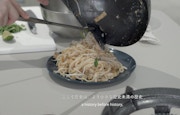キュレーションは翻訳なのか、それとも「静謐化」なのか
21_21 DESIGN SIGHTで開催されているドミニク・チェンのキュレーションによる展覧会「トランスレーションズ」は、「翻訳」という言葉を比喩的に利用している。会場は、「伝えかたをさぐる」「体でつたえる」「昔とすごす」「モノとのあいだ」などのゾーンに分かれています。8つのゾーンはそれぞれカラフルな三角柱でゆるやかに区切られているが、この柱は作品の音を隔離しているわけではないので、それぞれのナレーションを聞き取ることは難しく、会場の内部はノイズで埋め尽くされていた。
「ノイズ」という言葉は、空間デザインを担当した建築事務所の名前でもある「noiz」にも通じるもので、文字通りの意味(混沌とした音)と比喩的な意味(不確実性)の両方で「訳す」ことができます(*1)。

翻訳の性質としてのこの難しさは、例えばエラ・フランシス・サンダースの《翻訳できない世界のことば》とビデオ・ステートメント《トランス・ポート》を含む、「ことばの海をおよぐ」という領域で何よりも具体化されている。前者は世界各地の翻訳不可能な言葉の絵本からの抜粋であり、後者はチェンのキュレーションステートメントを言葉やフレーズごとに複数の言語に翻訳したものである。しかし同時に、Google Creative Lab+Studio TheGreenEyl+ドミニク・チェンによる《ファウンド・イン・トランスレーション》(2020)は、翻訳における言語の相互関係をグラフィカルに表現することで、翻訳の実用的な可能性とディープラーニング技術の限界を示唆しています(*2)。

《ファウンド・イン・トランスレーション》(2020)の展示風景 撮影=木奥惠三
翻訳とは、そのような不可能性と可能性のあいだで引き裂かれ、前者がイデオロギーに陥り、後者が実践のなかでかたちになることもあれば、その逆もある。エミリー・アプターの著書からタイトルを得た永田康祐の《Translation Zone》(2019)は、永田が「グローバル言語への欲望」と呼ぶ構造主義的な翻訳性、実用的な翻訳性、歴史的な非翻訳性のなかで、それぞれの地域文化の家庭料理のレシピの「翻訳」、つまり文字通りの「流用」がどのようなかたちをとっているのかを示している。この映像は、中国の炒飯、タイのข้าผวัด、インドネシアのナシゴレンなどのアジアの炒飯の構造的な相似性と文化的な側面での歴史的な違いをナレーションしたものである。このジレンマは「摩擦」と表現している。その理論的観察の後、音声は、これらの料理と名前が交錯するシンガポールの歌と、15世紀に中国からの移民とその子孫によってシンガポールにもたらされたプラナカン文化をルーツとするニョニャ料理を紹介する。本作品は、この「騒がしい」、つまり「クレオール」ゾーンでの生活習慣に焦点を当てています(*3)。

障害者のためのスポーツ感覚の「翻訳」、様々な「口述」装置、言いようのない奇妙な物体の手話による「表現」、微妙でプライベートな感情や経験のグラフィックな記録など、この「摩擦」やクレオール性は、私たちの身体やメンタリティ、あるいは個々の感情のあいだにも存在している。
しかし本展では、「翻訳」という言葉自体が、本来「変容」や「表象」と呼ぶべきものを比喩するためにすでに利用されている。ユリアーネ・レーベンティッシュが言うように、すべての美的経験が本質的に表象的な記号による自己反省から成り立っているとすれば、本展はその恣意的な「ゾーニング」や分類と、キュレーションにおける「翻訳」という言葉自体の翻訳とのあいだにあるクレオール性の可能性や摩擦を批判的に反映させるべきだったのではないだろうか。
縄文鍋の形や模様を現代の食器に転用したり、漬物の容器の状態を計算したり、人工的な匂いでサメを生理的に誘惑したりすることを自然に「翻訳」と呼び、キャプションに「翻訳」という言葉が引用符をつけられていることに気づくとき、それは「翻訳」という概念そのものを翻訳・解釈したいという欲求を反映していることに気づくだろう(*4)。 そして、その欲求こそがこの「メタファー」の根底にあるのだ。翻訳をテーマとする展覧会は、この欲望を反映し、翻訳の間を埋めるこの欲望をどのようにキュレーションが反映し、あるいは追従してきたのかを考えるべきであろう。

テーマとしての「翻訳」は、「翻訳」そのものの意味を恣意的に翻訳している。やんツーの《鑑賞から逃れる》(2019)のキャプションのどこにも「翻訳」という言葉は見当たらない。この不在(あるいはnoizのあの騒々しい空間)のなかで、翻訳の不可能性についてのシニカルな寓話を見るとき、私たちはすでにその空白を自分たちで埋めてしまっているのである。この展覧会では、この意味を満たす「セルフサービス」が、暗黙のうちに「翻訳」として機能しているのではないだろうか? あるいは、このような批評もまた、「翻訳」を恣意的にメタファー化したいという願望なのだろうか。
それぞれの翻訳は、それが具体的な行為者のために、具体的な行為者によって、具体的な行為者のあいだでの生活実践であり、その騒々しさや摩擦が自分自身に反映されて初めて翻訳と呼ぶことができるのである。私たちは、それぞれの翻訳が、具体的な文脈のなかでの「イロクテーション的行為」であることを忘れてはならない。この展覧会には「『わかりあえなさ』をわかりあおう」というサブタイトルがついているが、この種のスローガンは、翻訳における理解と誤解のあいだの実践的な相互作用をすでにつねに楽観的に昇華させている。つまり、翻訳をメタファーに翻訳するのは、脱ノイズ化や静謐化なのである。
このレビューは、一度英語で書かれたあと、DeepL が自動的に日本語に翻訳したものです(*5)。
*1──「noise」の語源はラテン語で船酔いを意味する「nausea」である。郷原佳以は、ミシェル・セールの論考のもと、ジャン=ポール・サルトルの『嘔吐(Nausea)』(1938)やオノレ・ド・バルザックの『知られざる傑作』(1831 )のなかの「La belle noiseuse」とnoiseとの語源的関係を論じている。郷原佳以「なんとなく、ノワズゥズ」『ユリイカ』2012年3月号特集「辞書の世界」(青土社)を参照。
*2──この翻訳のグラフィカルなイメージは、アントニ・ムンタダスの《On Translation》を彷彿とさせる。《The Internet Project》を彷彿とさせる。この作品でも、言語の相互関係を螺旋状に表現している。しかし、この螺旋状は任意の記号であるが、《ファウンド・イン・トランスレーション》の自動生成されたグラフィックは記号ではなく、メタコーパスの可視化である。そして、このグラフィックを中立的に考えたり、中立的に感じたりしないように注意しなければなりません。このメタコーパスは、各言語の単語やイディオムをベクトル化したものですが、この作業はGoogleが指示・可視化しています。
*3──また、動画のナレーションのクレオールっぽさにも注目してみましょう。ナレーションは日本人男性の声によるものと思われるが、ネイティブではないアクセントの英語であり、英語ではない単語は原語で発音されている(ネイティブではないアクセントがあるかもしれない)。このように英語のナレーションに刻まれたクレオール性は、現代アート、とくにナラトリアル・ビデオ・アートにおけるLingua Francaとしての英語の地位を反映している。
*4──伊藤亜紗+林阿希子+渡邊淳司の《見えないスポーツ図鑑》のプラクティスをなぜ「翻訳」と呼べるのか? この展示は、二つの練習をビデオで記録したものです。「感戦;試合を感じる」と「汗戦;試合を体験する」である。前者は、視覚障がい者と障がい者以外の人とのあいだで、スポーツの試合を見たときの感覚をどうやって伝えていくかを示しています。例えば、レスリングの試合を見るときには、タオルを1枚持っています。観戦する2人がそれぞれのレスラーを担当し、レスラーの動きに合わせて直感的にタオルを引っ張ったり引いたりすることで、視覚障害者に「試合の進行や力関係」を「身体感覚的なリズムや身体感覚に変換」して伝えるのである。この「翻訳」は文字通りの言語的なものではないが、「翻訳」と呼ぶにふさわしいものであることは認める。
いっぽうで、縄文壺のコピーやサメの生理的刺激を「翻訳」と表現することには違和感を覚える。何が違うのだろうか? この直感的な違いは、私が望む「翻訳」という概念の翻訳に対応している。その意味では、「翻訳」という言葉自体が、このような自己表現の文脈の中で脱構築的なものである。
後半でほのめかされたように、私の基準には仮説がある。翻訳とは、オースティン語的には、「illocutionary」であり、「perlocutionary act」である。感戦」では、実践者はこの「翻訳」の実践の可能性と限界の認識を共有しており、この有限性のなかで、表現可能な内容とその相互反射の表現の一種の役割を果たしている。しかし、サメの刺激や壺の形のコピーは、人間とサメ、あるいはそれぞれの壺の使用者の間で共有されている文脈を伝えるような内容を持っているわけではなく、また、少なくとも本展の展示では、この文脈の恣意性を反映しているわけでもないように思われる。翻訳とはつねに、翻訳行為そのものが利害関係者のあいだで起こる文脈の翻訳でもある。《汗戦》のビデオでは、そのような文脈がプロのアスリートによって反映されている。しかし、このような記述が「翻訳」を保証するほど中立的なものであるかどうか、また、この「理解」や「納得」のもとに排他的なプロフェッショナリズムを再現しているかどうかには注意を払わなければならない(professionは語源的にはラテン語の「profess」であり、宗教的信念の表明を意味します)。
*5──2021年1月4日にフリーライセンスで。もちろんタイトルや注釈も。しかし、固有名詞や引用の仕方、語源の説明などを例外的に修正した上で、編集者がガイドラインに沿って校正してくれました。
そこで、この文章について、何か報告しておかなければならないことがある。私の母語は日本語なので、英語の表現には不自然なところがあると思います(文法的なミスがなければいいのですが)。同時に、このレビューを書いている間、DeepL のプロトコルから発生する英語の「雑多さ」も常に感じています。一部のフレーズやニュアンスが無視されたり、反転したりすることが多いそのズレに対応するために、DeepL のインターフェイス上で表現の復元と変更を繰り返しました。書き換えは文法的な反省から判断したものもあれば、成功するまで「適当に」やってみたものもある。引用符や句読点の有無によって、変換された単語や文章が完全に変化することが多いが、これは文法的な変化ではなく、ユーザーにとってのブラックボックス化されたニューロネットワークによる再生成である。
むしろ、このようなブラックボックス化された同時翻訳では、私たちの言語は、自動翻訳のために翻訳しやすい異質な形に変換されていきます。それは、スマートスピーカーにうまく命令するために、言い換えを繰り返しているようなものです。このようなサービスの中では、私たちの自然言語は実行可能なコードに翻訳される運命にあります。 さらに言えば、永田氏の動画で示唆されているように、ユーザーが意図的に逸脱した教え方をすることで誤訳が学習されることもある。《ファウンド・イン・トランスレーション》のグラフィックの可視化を、もはや私たちは自然で中立的なものとして認識することはできない。
念のため、英語の原文のレビューは以下に残しておく。ところで、このサイト「ウェブ版美術手帖」では、日本語の記事を英語と中国語に自動翻訳するプラグインが用意されている。
- 1
- 2

























